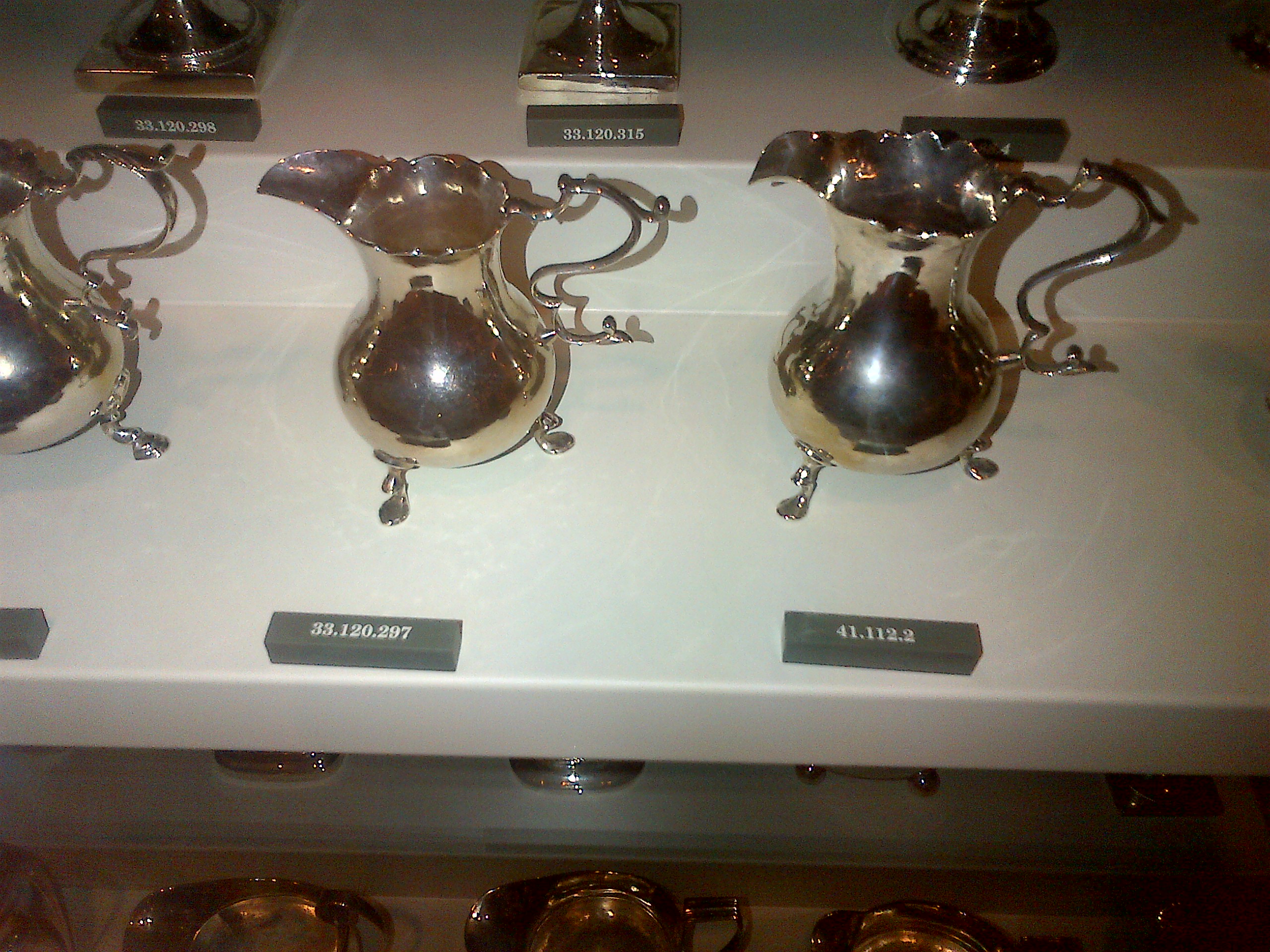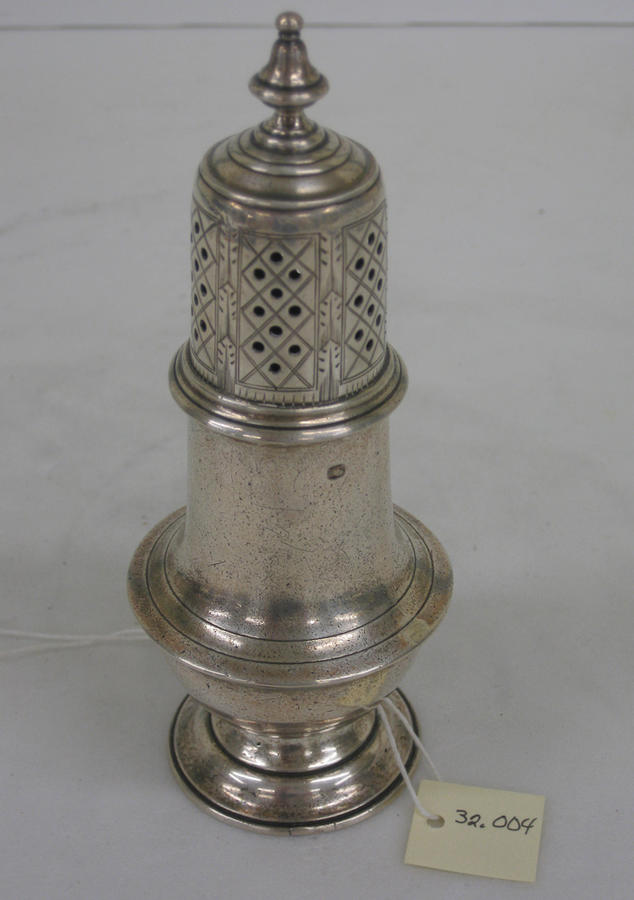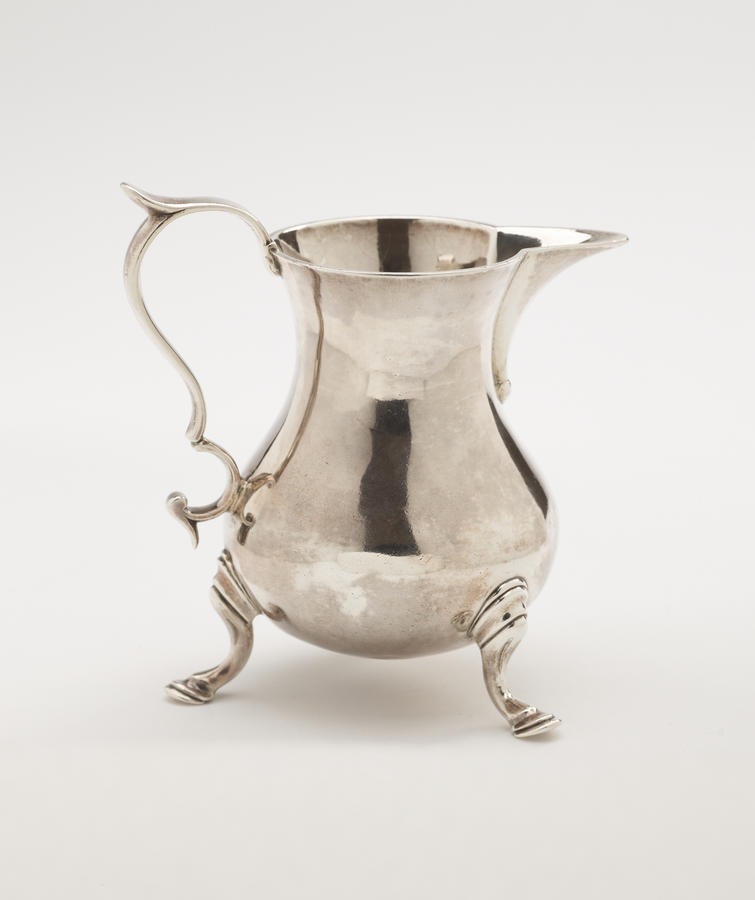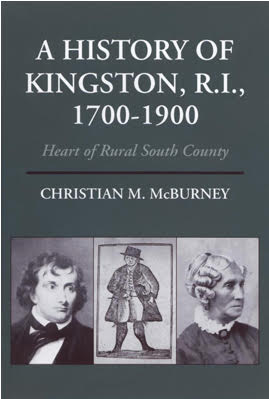Samuel Casey of Little Rest (now Kingston) was one of the most skilled silversmiths in colonial times in all of the colonies. His craftsmanship of silver tankards and teapots made him known throughout the Narragansett country, in Newport, and beyond. An expert from Boston’s Fine Arts Museum once said that among colonial silversmiths Casey’s work was second only to that of Paul Revere’s. Today, Casey’s pieces can be found in many of the nation’s most prestigious art museums, including the Metropolitan Art Museum in New York City, the Brooklyn Art Museum, the Yale University Art Gallery, and the Smithsonian museums in Washington, D.C. In Rhode Island, among other institutions, the Rhode Island School of Design Museum in Providence has some of Casey’s pieces.
Despite his skill and success as a brilliant silversmith, Casey turned to counterfeiting coins, which proved to be his downfall and ended in a dramatic jailbreak in Little Rest, which saved him from being hanged.
Counterfeiting money in colonial Rhode Island, including in South Kingstown, was a surprisingly common crime. This phenomenon was in part attributable to the large number of silversmiths in Rhode Island, and in particular in South Kingstown. Silversmiths had the technical skills to make dies for printing fake money. Indeed, silversmiths were hired by the colony to make devices for making official coins and printing official paper money. The frequency of counterfeiting may also reflect the uninhibited scramble for wealth in Rhode Island.
Samuel and Gideon Casey seemed to have become involved in counterfeiting at an early time in their careers as silversmiths. In 1752, when in Philadelphia, Gideon was thrown into jail for passing counterfeit money, found guilty at a trial, and fined £50. In 1754, Samuel and Gideon became persons of interest in an investigation of a counterfeiting ring in Rhode Island, but only three other men from West Greenwich and Exeter were tried and convicted in the Little Rest Court House. In 1768, authorities suspected that Gideon was the head of a gang of counterfeiters who operated around the Connecticut and Rhode Island border. After escaping Rhode Island, Gideon was caught on a schooner in New York City with counterfeiting dies and money. He was acquitted after a trial in New York “for want of sufficient evidence.”
Samuel Casey may have considered counterfeiting in earnest as a result of a personal disaster that befell him in the Fall of 1764. His house, which was located on main street in Little Rest at the northeast corner at the intersection of North Road, burned down, caused by a fire in his forge. The Boston News-Letter reported the following item:
Last Tuesday morning the House of Samuel Casey, Esq., at South Kingstown, Rhode Island, was reduced to Ashes. A large Variety of Furniture, a considerable Quantity of European goods, with Drugs, Medicines, etc. makes Mr. Casey’s Loss, as we are informed, amount to more than Two Thousand Pounds Sterling. The most of his Books, and a small Part of his Furniture, were the principal of what was saved. This Misfortune, we hear, was occasioned by a large Fire being kept the Day preceding in his Goldsmith’s Forge, which was so intense as to set Fire to a Poll at the back part of the Chimney.
The considerable sum that Casey lost demonstrates his success as a silversmith and storekeeper. In an age lacking fire insurance, much of the savings that Casey had worked for all these years disappeared in flames.
After the fire, Samuel Casey rebuilt a house and forge at the same site. Casey borrowed money to rebuild, using his remaining household goods and silversmith tools as collateral. Samuel continued to conduct his silversmith and storekeeping businesses at his house, without Gideon.

Tankard made by Samuel Casey in 1754 or 1755. The tankard was given to the Reverend Ezra Stiles by his students at Yale College, after Stiles served as tutor for them from 1749 to 1755. Stiles later became minister of a Congregational Church in Newport (Yale University Art Gallery)
Casey began associating with counterfeiters at this house in 1764, the year his house burned down. In February 1768, Massachusetts authorities were informed of Casey’s connections with a notorious Boston counterfeiter. Casey’s silversmith business apparently was not sufficient to repay his heavy debts and he turned to counterfeiting to supplement his income.
Yet the counterfeiting did not save Casey. His financial problems broke out in the open in March 1770, when he submitted a petition of insolvency to the General Assembly, signed by 27 of his creditors, including many prominent Newport merchants. In April 1770, the Newport Mercury published a notice that Samuel Casey was insolvent.
Samuel Casey still looked to counterfeiting to solve his financial difficulties. His reconstructed house in Little Rest became the headquarters for his gang of silversmith counterfeiters. Most of the counterfeiting of the bogus money took place in the attic of Casey’s house. Samuel Wilson of Tower Hill, and William Reynolds of Richmond, also counterfeited some money. Among the people who were present during the illegal activities were Noah Colton, William Reynolds, Samuel Wilson, and Gideon Casey. All of these men were silversmiths. The men had great screws and melted metal, which they used to turn out coined money. Sometimes their customers would bring them blanks of mixed metal to be stamped.
Casey was proud of his work and boasted to his nephew that his dollars would “pass through the world.” But he was overly optimistic. Elisha Reynolds (of Exeter, not the Little Rest merchant and founder), and Immanuel Case, a storekeeper in South Kingstown, were a few of the townsmen who were caught passing Casey’s coins.
One of the gravest dangers for any gang of counterfeiters was the threat of having a member betray the gang’s counterfeiting activities. To address this risk, Samuel Casey required everyone in his gang to take a solemn oath not to reveal “the secrets of any other man, woman or child without the consent of company or companions and to swear ‘If I am not true to you and do not keep all your council and your secrets I pray God to shut me out oil-leaven and make all my Prayers to become sin.’”
With the flood of counterfeit money, it was only a matter of time before the local authorities caught up with Samuel Casey. In July 1770, a local man, Thomas Clarke, was caught passing counterfeit coins. He confessed that the bad money was made “by the ole man upon the Hill,” meaning Casey on Little Rest Hill.
Casey was tipped off about the interest of the authorities. Casey ordered his nephew to take his counterfeiting tools and dies and throw them “into a sunken Swamp on Caleb Gardner’s Ground, where they cannot be found.” (Gardner, who lived immediately north of Casey, also owned a farm to the west near the Chipuxet River.) Casey also wrote a note of warning (with poor spelling) to his accomplice Samuel Wilson.

On the left, a beautiful pear-shaped creamer, ca. 1760, made by Samuel Casey (Metropolitan Museum of Art)
Casey was not quick enough. An immediate search was made in Casey’s home where a press for counterfeiting was found. In addition, Casey’s desperate note of warning addressed to Wilson was discovered. Under questioning, Casey admitted that two squares in the note were meant to indicate dies for counterfeiting.
Numerous suspected counterfeiters were taken into custody. But only Samuel Casey, William Reynolds, Thomas Clarke, Samuel Wilson, and Elisha Reynolds (of Exeter) were indicted at the October 1770 session of the superior court held at the Court House in Little Rest. These men were put in the King’s County Jail in Little Rest.
Prior to the trial, Casey made a full confession of his counterfeiting activities to the court sitting at Newport. He stated that he had made about 300 Spanish milled dollars and about 40 Portuguese coins. Nevertheless, he denied that he had passed any of the coins, but had merely given them to others, who had placed them into circulation. This last claim belied belief, of course.
In the October 1770 session of the superior court held at the Court House in Little Rest, Casey and the other four indicted men were placed on trial. They were represented by prominent attorneys Matthew Robinson of Newport and South Kingstown, and James Varnum of East Greenwich. The “Counsel for the King” also were prominent attorneys: James Honeyman and Henry Marchant of Newport. Presumably, the jury included many friends and acquaintances of Casey’s. The trial was presided over by a five-judge panel.
During the trial, Casey pled not guilty, and the jury agreed, bringing in a verdict of “not guilty,” apparently on the ground that his confessions made in Newport were not admissible evidence. The five-judge panel was not satisfied with the verdict and ordered the jury to go out another time and reconsider the verdict. This time the jury found Casey guilty on the condition that Casey’s confession was admissible. The court determined that the evidence was admissible and that therefore Casey was guilty.
Counterfeiting was treated as a serious crime in colonial times, as it only cheated the individuals who found themselves holding worthless money. Such individuals could be driven into bankruptcy and send to debtor’s prison. It also undermined confidence in a pillar of the colony’s economy, its money. Accordingly, those guilty of counterfeiting could be hanged.

A castor for shaking sugar, known as a muffineer, made by Samuel Casey (Rhode Island School of Design Museum)
The Connecticut Courant decried, with remarkable exaggeration, that “a more horrid and extensive combination to defraud the public, has never been heard of in New England.” The judges sentenced Casey to be hanged “until he be dead” between the hours of nine in the morning and two in the afternoon on a day in the near future.
Casey’s accomplices, Samuel Wilson, William Reynolds, Elisha Reynolds, and Thomas Clark, were also found guilty. Wilson’s trial lasted ten hours, but the jury convicted him in ten minutes. The Providence Gazette, in its October 20, 1770, edition, reported the following shocking news:
At the Superior Court held for King’s County, on Thursday last, Samuel Casey, of South Kingstown, received Sentence of Death, for making and passing counterfeit Money. Samuel Wilson, of the same Town, was sentenced to stand in the Pillory, be branded on both Cheeks, have both Ears cropped, and pay a Fine of Six Hundred Pounds Lawful Money. William Reynolds, of Richmond, was sentenced to stand in the Pillory, have both ears cropped, and pay a Fine of Three Hundred Pounds Lawful Money. Thomas Clark, of the same Town, was sentenced to stand in the Pillory, be branded on both Cheeks, have both ears cropped, and pay a Fine of One Hundred Pounds Lawful Money. Elisha Reynolds was sentenced to stand in the Pillory, and to be whipped Thirty-nine Lashes; all for the like Crimes.
The punishments were originally to be inflicted at the pillory in Little Rest. But perhaps to accommodate the expected large crowds, the punishments instead were meted out at Tower Hill, located on the Post Road. The story of Samuel Casey and his accomplices was soon so widely known that it was reported that on October 26, 1770, more than 3,000 people gathered on Tower Hill to witness the tortures inflicted upon Wilson, Clark, and William Reynolds. The crowd’s morbid fascination was satisfied as each convicted man was branded on both cheeks with a hot iron with the letter “R” on it (for “rogue”) and had his ears cropped (a piece of each ear was cut off).
Elisha Reynolds of Exeter was not reported to have been punished at Tower Hill. His punishment of standing in the pillory for one hour and being whipped with “thirty-nine lashes on his naked back” may have been carried out in Little Rest.
Samuel Casey was scheduled to hang after the punishments were meted out to his four accomplices. His hanging may have been delayed in order for the General Assembly to consider his petition for reducing his penalty.
Casey had many friends in Little Rest and King’s County, as was evidenced by the reluctance of the jury to convict him. These men felt that Casey’s sentence of death by hanging was too harsh. At a time when criminal punishments were often overly harsh in light of the crime committed, citizens sometimes took justice into their own hands in order to apply leniency.
On the night of November 3, 1779, Casey’s friends, from around the county and village, gathered at Thomas Potter’s tavern in Little Rest and made plans to free the prisoner. That night, according to a newspaper report, “a considerable Number of People riotously assembled” in Little Rest, with their faces blacked,” and headed for the jail where Casey was being kept. With “Iron-bars and Pick-axes,” the men broke open the outer door of “his Majesty’s Gaol” and set Casey free. Three other convicted counterfeiters—William Reynolds, Elisha Reynolds, and Thomas Clark—were also freed.
With a death sentence hanging over his head, Samuel Casey was then furnished with a horse, and he rode as fast as possible towards Connecticut. He never returned to Little Rest.
Immediately after the dramatic jailbreak, the General Assembly offered a reward of £50 for any information leading to the arrest of any of the jail breakers and another £50 for the capture of Casey. Although numerous arrests were made, at the April 1771 session of the superior court in Little Rest, only three men were punished with stiff fines. At the same session, a fifth man, William Carlisle of Exeter, was convicted of passing counterfeit money. He was sentenced to stand an hour in the Little Rest pillory, be branded with the letter “R” on both cheeks, and have both ears cropped.
During the American Revolutionary War, Martha Casey, Samuel’s long-suffering wife, submitted a petition to the General Assembly seeking amnesty for her husband. Casey, according to the 1779 petition, “wandered in exile nine years forlorn and forsaken and destitute of every means of support . . . separated from his wife and offspring.” The General Assembly voted to pardon the former silversmith, but Samuel never took advantage of it. It may have been that he could not possibly have done so. A Canadian descendant of Samuel’s reported that he was loyal to King George III in the American Revolutionary War and was killed as a Tory. This report is somewhat supported by evidence that Samuel Casey’s adult son fought as a Tory and after the war fled to Canada.

A teapot made by Samuel Casey, ca. 1745. The earliest monogram is that of Sarah Pope, who married William Redwood in 1757; William Redwood was the son of Abraham Redwood, the founder of the Redwood Library and Athenaeum (Redwood Library and Athenaeum)
The General Assembly pardoned Casey only for acts occurring prior to April 19, 1775, the date of the Battle of Lexington and Concord, the outbreak of the Revolutionary War. It appears the General Assembly may have suspected Samuel was a Loyalist and therefore did not want to pardon him for any “crimes” he may have committed during the war.
Casey’s house, which became known as the old Helme House, after it housed James Helme’s store and family, later served as the residence of a Black abolitionist, Sarah Harris Fayerweather. It was torn down in 1910. Prior to the demolition, a search of the attic turned up a pressing die, which was determined to have been used for counterfeiting by Samuel Casey.
[Almost all of this article derives from a chapter in Christian McBurney, A History of Kingston, R.I., 1700-1900, Heart of Rural South County (Kingston, RI: Pettaquamscutt Historical Society, 2004). The sources for this article are also set forth at the end of this book. A list of holdings of some of Samuel Casey’s works by museums and other institutions is set forth in Exhibit A to this book.]



























